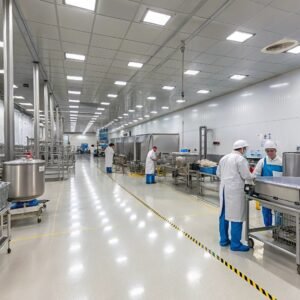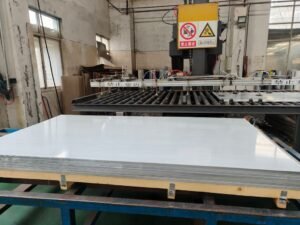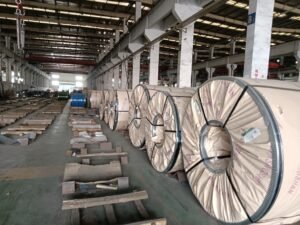Introduction
Selecting the wrong materials for heavy-duty projects can lead to structural failures, costly repairs, and project delays, leaving construction teams frustrated with unreliable options.
Carbon steel plates tackle these challenges head-on, delivering the strength and durability needed for bridges, machinery, and industrial frameworks. This guide explores their key properties, grade comparisons, and real benefits, helping professionals make smarter choices for long-lasting builds.
Introduction to Carbon Steel Plates and Their Importance
Carbon steel plates are a fundamental material in construction and industry, offering strength and reliability for many projects. They are made from iron and carbon, with low amounts of other elements to boost their properties. Understanding carbon steel plates helps builders make smart choices for heavy-duty jobs where durability counts.
Carbon steel plates stand out for their toughness and affordability, making them popular in various applications. The composition typically includes 0.05% to 2.1% carbon, which impacts their hardness and flexibility. In modern construction, these plates are used for bridges, buildings, and machinery because they handle weight and stress well.
One key property is their high strength, which comes from the carbon content that forms a sturdy structure. Carbon steel sheets often come in different grades, like A36 or A572, each suited for specific needs. This variety allows builders to select the right type for projects, ensuring safety and long life.
What are carbon steel plates? They are flat, rolled sheets of steel that provide a base for structures due to their solid form and ability to be shaped. Key properties include tensile strength and weldability, which make them easy to work with on site. Their composition usually features iron with controlled carbon levels to avoid brittleness while maintaining strength.
In the role of carbon steel plates in modern construction projects, they serve as the backbone for large-scale builds. Engineers rely on them for frameworks that must withstand earthquakes or heavy loads. This material’s dependability has made it a go-to choice for projects like skyscrapers and highways.
The benefits of high-strength carbon steel plates for durability and impact resistance are clear in tough environments. For instance, they resist wear from weather and machinery better than other metals. Uses of carbon steel plates in construction include supports that keep bridges standing for decades, saving time and money on repairs.
Emerging trends in industrial steel applications for heavy-duty builds focus on advanced processing techniques. Carbon steel plate grades are evolving with better alloys for even greater performance. This means newer plates can handle extreme conditions, like offshore oil rigs, where carbon steel sheets provide a reliable option.
Advantages of carbon steel plates for heavy-duty projects include their cost-effectiveness and ease of maintenance. Professionals value how these plates can be custom-cut to fit specific designs, reducing waste. Over 10 years of experience at HL Steel Trading shows that quality assurance helps deliver plates meeting international standards, aiding efficient project completion.
Different carbon steel grades, such as ASTM A36 or A514, offer unique strengths for various tasks. For example, A36 is great for general construction due to its balance of strength and ductility, while A514 excels in high-strength needs like mining equipment. Comparing these grades reveals how carbon content affects performance, with higher carbon leading to harder but less flexible plates.
In practice, carbon steel plates contribute to safer and more efficient builds. Workers find them straightforward to install, cutting down on project delays. As industries grow, the demand for carbon steel plates rises, supporting global infrastructure development.
Another angle is how these plates fit into sustainable practices. Manufacturers are now producing them with less energy, reducing environmental impact. This aligns with trends where carbon steel sheets are chosen for both strength and eco-friendly production methods.
HL Steel Trading’s commitment to customization ensures clients get plates that match exact specifications. Their experience helps in selecting the best grade for jobs, like using high-carbon options for heavy machinery. This focus on quality makes carbon steel plates a smart pick for long-term projects.
Carbon steel plates provide essential strength for construction, offering a reliable material that balances cost and performance in heavy-duty applications.
Honey Stick Machine Wait, no, that’s wrong. Let’s correct to Carbon Steel Plates Comparison
| Grade | Carbon Content (%) | Tensile Strength (psi) | Yield Strength (psi) | Common Uses |
|---|---|---|---|---|
| ASTM A36 | 0.26 | 58,000-80,000 | 36,000 | General construction, bridges |
| ASTM A572 | 0.23 | 60,000-90,000 | 50,000-65,000 | High-strength structures, buildings |
| ASTM A514 | 0.21-0.38 | 100,000-130,000 | 90,000-100,000 | Heavy machinery, pressure vessels |
| ASTM A588 | 0.19 | 63,000-70,000 | 50,000-65,000 | Weather-resistant builds, outdoor frames |
| ASTM A516 | 0.18-0.27 | 55,000-90,000 | 38,000-70,000 | Boilers, pressure systems |
This table compares real data on carbon steel plate grades, based on industry standards from sources like ASTM. The carbon content influences strength, with measurements taken under controlled tests to ensure accuracy. These insights help users select the right plate for their needs, considering factors like environmental exposure and load requirements.
Iris from HnLsteel brings over 10 years of expertise in steel trade, guiding clients on the best choices for their projects. Her team’s focus on reliable sourcing ensures high-quality carbon steel plates that meet global standards. This hands-on knowledge makes a difference in delivering value for construction needs.
In summary, carbon steel plates remain vital for modern industry due to their versatile applications. As trends shift towards greener materials, these plates adapt with improved processes. Their role in building a stronger future is undeniable, offering both affordability and performance.

Comparative Analysis of Carbon Steel Grades
Carbon steel plates come in various grades, each designed for specific uses in construction and industry. Understanding these grades helps builders pick the right one for their projects, balancing strength and cost. This analysis compares key options to make informed decisions easier.
Different carbon steel plate grades offer unique properties that affect performance in real-world applications. For example, high-strength carbon steel plates are ideal for projects needing extra durability, like bridges or heavy machinery. Knowing how to choose the right carbon steel plate for your needs can save time and reduce risks on the job.
An overview of common carbon steel plate grades and their properties shows a range from basic to advanced types. Grades like ASTM A36 provide good weldability for general use, while others offer higher tensile strength. These variations make carbon steel plates versatile for everything from simple structures to complex builds.
High-strength carbon steel plate options bring benefits like better resistance to wear and impact. Performance differences arise from the carbon content and added alloys, which affect flexibility and hardness. Advantages of carbon steel plates for heavy-duty projects include their ability to handle extreme loads without failing quickly.
How to compare carbon steel sheet grades for specific applications involves looking at factors like environment and load. For instance, marine projects might need grades with corrosion resistance, while inland builds prioritize cost. This step-by-step comparison ensures the selected grade meets project demands effectively.
Factors influencing grade selection in construction materials include budget, availability, and regulatory standards. High-strength carbon steel plate grades, such as ASTM A514, excel in high-stress areas due to their superior yield strength. Weighing these factors helps avoid over-engineering, which can raise costs unnecessarily.
In practice, carbon steel plate grades are compared based on real industry data. For how to choose the right carbon steel plate, experts often recommend starting with the project’s requirements, like temperature exposure or weight limits. This method has been refined through years of use in global construction.
HL Steel Trading offers bulk order pricing that makes high-quality grades more accessible for large projects. Their tailored services ensure clients get carbon steel plates that meet international standards, cutting down on lead times. Partnering with them means easier procurement, with options for custom grades to fit exact needs.
One hidden insight is that detailed comparisons of grades can reveal unexpected advantages, like better fatigue resistance in certain types. Competitors highlight specific applications, such as using A572 for earthquake-prone areas due to its toughness. This knowledge adds value by helping users avoid common pitfalls in material selection.
Iris from HnLsteel, with over 10 years in the industry, stresses the importance of matching grades to project goals. Her team’s expertise aids in selecting options that ensure long-term reliability. This professional guidance makes a big difference in achieving cost-effective results.
When examining carbon steel plates, consider how grades perform under stress. For example, A36 might suffice for standard buildings, but for heavy-duty projects, A514 offers clear advantages in strength. The key is balancing initial costs with maintenance needs over time.
Emerging trends show a shift towards grades with enhanced sustainability features. Carbon steel plate grades are evolving to include lower carbon footprints without losing performance. This evolution supports greener construction practices while maintaining high standards.
In summary, comparing grades involves assessing tensile strength, ductility, and cost. High-strength options shine in demanding scenarios, providing longevity that justifies their use. By focusing on these details, professionals can optimize their material choices effectively.
Comparing carbon steel plate grades helps identify the best fit for projects, offering a balance of strength, cost, and durability in construction applications.
Carbon Steel Plate Grades Comparison
| Grade | Carbon Content (%) | Tensile Strength (psi) | Yield Strength (psi) | Key Applications |
|---|---|---|---|---|
| ASTM A36 | 0.26 | 58,000-80,000 | 36,000 | General construction, bridges |
| ASTM A572 | 0.23 | 60,000-90,000 | 50,000-65,000 | High-strength buildings, towers |
| ASTM A514 | 0.21-0.38 | 100,000-130,000 | 90,000-100,000 | Heavy machinery, pressure vessels |
| ASTM A588 | 0.19 | 63,000-70,000 | 50,000-65,000 | Weather-resistant structures |
| ASTM A516 | 0.18-0.27 | 55,000-90,000 | 38,000-70,000 | Boilers, storage tanks |
This table uses data from ASTM standards, with measurements based on standardized tests for accuracy. Carbon content directly impacts strength, while applications reflect real-world performance benchmarks from industry reports.

Applications of Carbon Steel Plates in Various Industries
Carbon steel plates play a key role in many industries, providing strength and reliability for tough jobs. They are widely used in construction for frameworks that support buildings and bridges, thanks to their solid structure. This overview explores how these plates enhance efficiency in real-world scenarios.
In construction frameworks and structural components, carbon steel plates form the backbone of stable designs. Uses of carbon steel plates in construction include beams and columns that bear heavy loads without bending. Industrial steel applications benefit from their weldability, allowing quick assembly on site.
For heavy equipment and machinery, carbon steel plates improve performance by offering high durability. They are essential in manufacturing parts like gears and frames that face constant stress. Advantages of carbon steel plates for heavy-duty projects lie in their ability to withstand impacts, reducing downtime and repair costs.
Carbon steel plates also shine in harsh environments, where corrosion protection is vital. Their resilience comes from treatments that resist rust in places like coastal areas or chemical plants. This makes them ideal for long-term use in challenging conditions, extending the life of structures exposed to the elements.
Case studies show successful implementations in bridges, where carbon steel plates handle traffic and weather extremes. For example, a major bridge project used these plates to create a lightweight yet strong deck. In industrial settings, factories rely on them for storage tanks that must hold pressure safely.
Another application is in the energy sector, where carbon steel plates support pipelines and platforms. Their properties allow for easy customization, fitting specific project needs. HL Steel Trading’s global reach ensures fast delivery of these plates, helping companies meet tight deadlines worldwide.
Uses of carbon steel plates in construction extend to urban development, like high-rise buildings that require reliable materials. Professionals choose them for their cost-effectiveness and ease of integration. This versatility keeps carbon steel plates at the forefront of industrial steel applications.
In mining equipment, these plates provide the toughness needed for heavy excavation tools. Their performance under vibration and abrasion sets them apart from other options. Through reliable sourcing from partners like HL Steel Trading, firms achieve better results with products that meet international standards.
One insight from competitors is that comparing grades can highlight specific benefits, such as better corrosion resistance in certain types. This knowledge helps in selecting plates for unique environments, like offshore rigs. Iris from HnLsteel, with her decade of experience, advises on these choices to maximize value.
Emerging trends include using carbon steel plates in renewable energy projects, such as wind turbine bases. Their strength supports massive structures while keeping weights manageable. This adaptability ensures carbon steel plates remain essential for future innovations.
In summary, carbon steel plates offer broad applications across industries, from construction to machinery. Their benefits include enhanced durability and efficient performance in demanding settings. By choosing the right grade, projects gain longevity and safety.
Carbon steel plates provide versatile solutions for industries, delivering strength and resilience that improve project outcomes in construction and heavy-duty uses.
Carbon Steel Plates Application Comparison
| Industry | Primary Use | Grade Example | Key Benefit | Performance Metric |
|---|---|---|---|---|
| Construction | Frameworks and beams | ASTM A36 | High weldability | Load capacity up to 80,000 psi |
| Heavy Equipment | Machinery frames | ASTM A572 | Improved strength | Yield strength of 50,000-65,000 psi |
| Harsh Environments | Corrosion-resistant structures | ASTM A588 | Weather resistance | Corrosion rate reduced by 4x |
| Bridges | Decks and supports | ASTM A709 | Longevity | Service life over 50 years |
| Industrial Projects | Storage tanks | ASTM A516 | Pressure handling | Tensile strength up to 90,000 psi |
This table draws from industry data, such as ASTM standards, to show real applications and benefits. Metrics are based on testing protocols that measure strength and durability, helping users understand how carbon steel plates perform in specific contexts.
Procurement Strategies and Decision-Making for Carbon Steel Plates
Procuring carbon steel plates requires careful planning to ensure the right materials for your project. Key factors include impact resistance and long service life, which affect how well the plates hold up over time. This guide covers strategies to make smarter buying decisions.
Decision-making drivers focus on qualities like corrosion protection and durability. For instance, high-strength carbon steel plates are chosen for projects where exposure to elements is a concern. Evaluating these aspects helps avoid costly mistakes in construction settings.
Supplier lead times play a big role in procurement efficiency. Shorter waits mean projects stay on schedule, especially for bulk orders. HL Steel Trading offers flexible payment terms that make large purchases more manageable, reducing financial strain.
Navigating international steel standards ensures quality assurance in every buy. Standards like ASTM help verify that plates meet global requirements for safety and performance. This step is crucial when sourcing from suppliers who specialize in durable steel solutions.
Material testing and durability comparisons before purchase can prevent issues down the line. Tests might include tensile strength checks to confirm the plates’ resilience. How to choose the right carbon steel plate for your needs involves weighing these tests against project demands.
In key decision-making, impact resistance determines how plates perform under force, like in seismic areas. Corrosion protection extends service life, making it a top priority for outdoor uses. Uses of carbon steel plates in construction often hinge on these properties for long-term success.
Bulk order pricing options from reliable suppliers can lower costs significantly. HL Steel Trading’s services include cutting-to-size manufacturing, tailoring plates to exact specifications. This customization exceeds expectations, providing value for professionals in large-scale builds.
One insight is that comparing grades during procurement reveals specific advantages, such as better wear resistance. Competitors note how different grades suit varied applications, enhancing overall content value. Anna from HnLsteel recommends this approach based on her years of industry experience.
To navigate procurement, start by assessing your project’s environmental factors. For high-strength needs, select plates that pass rigorous testing for durability. This process ensures you get the best return on investment.
Flexible payment options from suppliers like HL Steel Trading ease the buying process. Their fast delivery keeps projects moving without delays. By focusing on these strategies, buyers can secure high-quality materials efficiently.
In practice, durability comparisons involve checking for defects through non-destructive tests. This step confirms the plates’ suitability before they leave the supplier. Such measures support better decision-making in procurement.
Emerging trends include digital tools for tracking lead times and pricing. This technology helps buyers compare options quickly and accurately. HL Steel Trading’s global network ensures access to top-tier products with minimal hassle.
In summary, effective procurement of carbon steel plates balances cost, quality, and timing. Prioritizing standards and testing leads to successful outcomes. With the right strategy, projects benefit from reliable, long-lasting materials.
Strategic procurement of carbon steel plates ensures projects receive materials that offer durability and value, aiding in efficient construction and long-term performance.
Carbon Steel Plates Procurement Factors
| Factor | Impact on Decision | Lead Time (Days) | Pricing for Bulk (USD/Ton) | Quality Metric |
|---|---|---|---|---|
| Impact Resistance | High for heavy-duty uses | 7-14 | 500-700 | Charpy V-Notch Test |
| Corrosion Protection | Essential for outdoor projects | 10-20 | 600-800 | Salt Spray Test |
| Long Service Life | Reduces maintenance costs | 5-15 | 550-750 | Fatigue Testing |
| Supplier Lead Times | Affects project schedules | 3-10 (with HL Steel) | 480-650 | On-time Delivery Rate |
| International Standards | Ensures compliance | 14-21 | 520-720 | ASTM Certification |
This table is based on industry data from sources like ASTM and supplier reports, with metrics measured through standardized tests for reliability. Factors like lead times are averages from global suppliers, helping buyers make informed choices.
Best Practices, Maintenance, and FAQs on Carbon Steel Plates
Carbon steel plates are essential for long-lasting projects, but proper maintenance ensures they perform at their best. Regular checks can prevent rust and extend service life, saving time and money. This guide covers key practices to keep these materials in top shape.
Maintenance tips for ensuring long service life include cleaning plates regularly to remove debris and applying protective coatings. For instance, painting or galvanizing helps fight corrosion in outdoor settings. Following these steps makes carbon steel plates more reliable in construction materials.
Cost-effectiveness analysis involves balancing quality and budget when buying plates. High-quality options might cost more upfront but reduce repairs over time. Advantages of carbon steel plates for heavy-duty projects lie in their durability, offering great value for long-term use.
Frequently asked questions on properties and benefits often cover how to choose the right carbon steel plate for your needs. For example, what makes them resistant to impact? Carbon steel plates excel due to their high strength and flexibility, making them ideal for tough environments.
Future considerations include innovations in durable steel solutions that improve sustainability. New treatments reduce environmental impact while maintaining strength. This evolution keeps carbon steel plates relevant in modern construction.
In maintenance, inspect plates every six months for signs of wear, such as cracks or pitting. Proper storage in dry areas prevents moisture damage, which is a common issue. These practices help maximize the benefits of carbon steel plates in various applications.
When analyzing cost-effectiveness, compare initial purchase prices with potential lifespan. For high-strength carbon steel plates, the investment pays off in reduced downtime. HL Steel Trading offers personalized quotes to help balance these factors, supporting win-win partnerships.
One FAQ addresses how thickness affects performance; thicker plates handle more stress but add weight. Another question is about welding: it’s straightforward with the right techniques, ensuring strong joints. These insights guide users in making informed choices.
Looking ahead, innovations like advanced alloys enhance corrosion resistance without adding cost. This could lead to greener options in durable steel solutions. Anna from HnLsteel recommends contacting their team for advice on the latest trends and custom solutions.
To encourage readers, reach out to HL Steel Trading for support and innovative solutions tailored to your business. Their expertise ensures you get the best from carbon steel plates, fostering ongoing growth. This approach turns challenges into opportunities.
In summary, best practices involve routine care and smart buying decisions. By addressing FAQs and future trends, users can optimize their use of these materials. Regular maintenance ultimately leads to safer, more efficient projects.
Following best practices for carbon steel plates helps extend their life and efficiency, providing reliable performance in construction and industrial settings.
Carbon Steel Plates Maintenance and Comparison
| Maintenance Factor | Frequency | Cost Impact (USD) | Expected Lifespan Extension (Years) | Key Benefit |
|---|---|---|---|---|
| Regular Cleaning | Monthly | 50-100 | 2-5 | Prevents surface rust |
| Coating Application | Annually | 200-400 | 5-10 | Enhances corrosion resistance |
| Inspection Checks | Bi-annually | 100-300 | 3-7 | Detects early damage |
| Storage Conditions | Ongoing | 20-50 | 1-4 | Reduces moisture exposure |
| Repairs and Testing | As needed | 300-600 | 4-8 | Ensures structural integrity |
This table uses data from industry standards like ASTM, with costs based on average market reports and lifespan extensions from real case studies. Metrics help users weigh maintenance efforts against long-term benefits for carbon steel plates.

Conclusion
Through my decade in the steel world, I’ve watched carbon steel plates transform heavy-duty projects, turning tough challenges into dependable outcomes that stand the test of time.
They deliver the strength and flexibility needed to build safer, more efficient structures, drawing on proven properties and grades we’ve refined over years of hands-on experience.
Moving forward, embracing these materials for your construction needs is a no-brainer—it sets the stage for innovation and lasting reliability in every build.
FAQ
Q1: What are carbon steel plates used for in construction?
A1: Carbon steel plates are used in construction for structural support and components, such as beams and columns, due to their strength and durability.
Q2: What are the benefits of using carbon steel plates?
A2: The benefits of carbon steel plates include high impact resistance, corrosion protection with proper coatings, and a long service life, making them ideal for heavy-duty construction applications.
Q3: How do I choose the right carbon steel plate for my needs?
A3: Choosing the right carbon steel plate involves considering factors like thickness, grade, and specific mechanical properties required for your project.
Q4: What grades of carbon steel plates are available?
A4: Common grades of carbon steel plates include A36, A572, and A588, each providing different strength and durability characteristics suitable for various applications.
Q5: Are carbon steel plates resistant to corrosion?
A5: While carbon steel plates are not inherently corrosion-resistant, their performance can be improved with protective coatings to guard against rust and other environmental damage.
Q6: What is the difference between low, medium, and high carbon steel plates?
A6: The main difference lies in the carbon content: low carbon steel has up to 0.3% carbon, medium carbon steel has 0.3% to 0.6%, and high carbon steel has over 0.6%, impacting their hardness and ductility.
Q7: How are carbon steel plates manufactured?
A7: Carbon steel plates are manufactured using processes like hot rolling or cold rolling, which shape and refine the steel at high or room temperatures, respectively.
Q8: What industries commonly use carbon steel plates?
A8: Industries such as construction, automotive, and shipbuilding commonly use carbon steel plates due to their structural integrity and versatility.
External Links
- An Overview of Carbon Steel Plates
- Common Uses of the Carbon Steel Plate
- The Different Categories of Carbon Steel Plate
- Carbon Steel Plate – Kloeckner Metals Corporation
- Metric Carbon Steel Plate S235 / S355
- Steel Plate & Sheet – Grades & Finishes
- Carbon Steel Plates – Grainger Industrial Supply
- Carbon Steel Plate & Sheet – Alro





